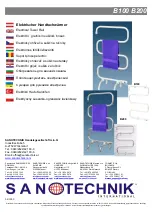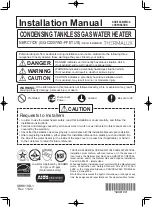
Direct Gas Make-Up Air
15
To Unit Supply
Connection
Gas Valve
From
Gas
Supply
6 in. Trap
1/8 in. Plugged Tap
Ground Joint Union
Supply Gas Line
2. Install Additional Regulator if Required
When the supply gas pressure exceeds the maximum
gas pressure shown on the direct gas nameplate, an
additional regulator is required to reduce the pressure.
The regulator must be a full lock up type. Additionally,
it must incorporate a listed leak limiting device or be
vented to the outdoors.
3. Connect the Supply Gas Line
A manual shut off valve, 1/8 in. plugged test port and
6 in. drip leg must be installed prior to the gas train.
The valve and the test port must be accessible for the
connection of a test gauge. Supply gas connections
must be made by a qualified installer and are not
furnished by manufacturer.
4. Test the System for Leaks
Check both the supply lines and the factory piping for
leaks. Apply a soap and water solution or equivalent to
all piping and watch for bubbling which indicates a leak.
The factory piping has been checked for leaks, but
must be rechecked due to possible movement during
shipping and installation.
Installation
Piping
All gas piping must be installed in accordance with
the latest edition of the National Fuel Gas Code ANSI/
Z223.1 and any local codes that may apply. In Canada,
the equipment shall be installed in accordance with
the Installation Code for Gas Burning Appliances and
Equipment (CGA B149) and Provincial Regulations for
the class. Consult authorities having jurisdiction before
installations are made. All piping must be clean and free
of any foreign matter. Foreign material entering the gas
train can damage the valves, regulators and burner.
Do not connect the unit to gas types other than what is
specified and do not connect the unit to gas pressures
that are outside of the pressure range shown on the
label.
When connecting the gas supply, the length of the
run must be considered in determining the pipe size
to avoid excessive pressure drop. Refer to a Gas
Engineer’s Handbook for gas pipe capacities.
1. Determine the Supply Gas Requirements
The unit’s direct gas nameplate states the requirements
for the gas being supplied to the unit. The direct gas
nameplate is located on the outside of the unit on the
control center side.
Direct Gas Nameplate
Type
of gas
Maximum
gas
pressure
Minimum gas pressure for
design temperature rise
WARNING
NEVER test for a gas leak with an open flame.
Gas
WARNING
All components of this or any other gas-fired heating
unit must be leak tested prior to placing the unit into
operation. Use a soap and water solution or equivalent
to perform this test. NEVER test for gas leaks with an
open flame.
When leak testing pressures that are equal to
14 in. wg (3.5 kPa), first close the field-installed shutoff
valve to isolate the unit from the gas supply line.
When leak testing pressures that are above 14 in. wg
(3.5 kPa), close the field-installed shutoff valve,
disconnect the furnace and gas train from the gas
supply line, and plug the supply line before testing.
















































